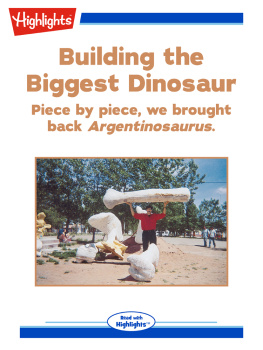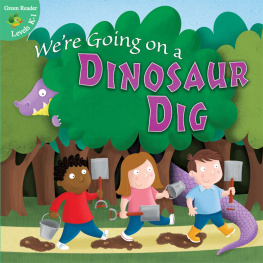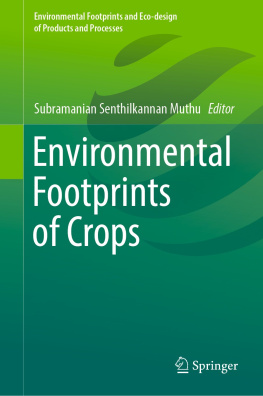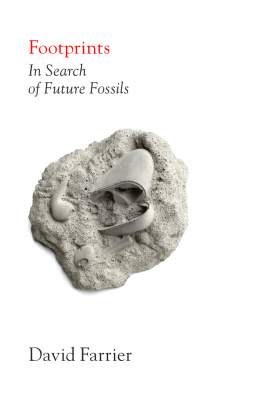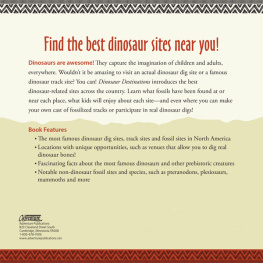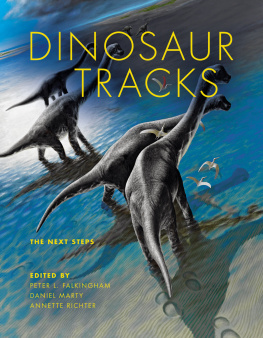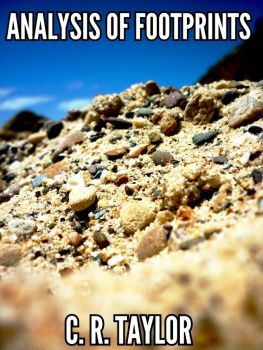Pérez Lorente - Dinosaur Footprints and Trackways of La Rioja
Here you can read online Pérez Lorente - Dinosaur Footprints and Trackways of La Rioja full text of the book (entire story) in english for free. Download pdf and epub, get meaning, cover and reviews about this ebook. City: Bloomington;La Rioja (Spain);Spain;La Rioja, year: 2015, publisher: Indiana University Press, genre: Children. Description of the work, (preface) as well as reviews are available. Best literature library LitArk.com created for fans of good reading and offers a wide selection of genres:
Romance novel
Science fiction
Adventure
Detective
Science
History
Home and family
Prose
Art
Politics
Computer
Non-fiction
Religion
Business
Children
Humor
Choose a favorite category and find really read worthwhile books. Enjoy immersion in the world of imagination, feel the emotions of the characters or learn something new for yourself, make an fascinating discovery.

- Book:Dinosaur Footprints and Trackways of La Rioja
- Author:
- Publisher:Indiana University Press
- Genre:
- Year:2015
- City:Bloomington;La Rioja (Spain);Spain;La Rioja
- Rating:4 / 5
- Favourites:Add to favourites
- Your mark:
- 80
- 1
- 2
- 3
- 4
- 5
Dinosaur Footprints and Trackways of La Rioja: summary, description and annotation
We offer to read an annotation, description, summary or preface (depends on what the author of the book "Dinosaur Footprints and Trackways of La Rioja" wrote himself). If you haven't found the necessary information about the book — write in the comments, we will try to find it.
Dinosaur Footprints and Trackways of La Rioja — read online for free the complete book (whole text) full work
Below is the text of the book, divided by pages. System saving the place of the last page read, allows you to conveniently read the book "Dinosaur Footprints and Trackways of La Rioja" online for free, without having to search again every time where you left off. Put a bookmark, and you can go to the page where you finished reading at any time.
Font size:
Interval:
Bookmark:
Dinosaur Footprints &
Trackways of La Rioja
Life of the Past James O. Farlow, editor

FOOTPRINTS
& TRACKWAYS
OF LA RIOJA
Flix Prez-Lorente
This book is a publication of
Indiana University Press
Office of Scholarly Publishing
Herman B Wells Library 350
1320 East 10th Street
Bloomington, Indiana 47405 USA
iupress.indiana.edu
2015 by Flix Prez-Lorente
All rights reserved
No part of this book may be reproduced or utilized in any form or by any means, electronic or mechanical, including photocopying and recording, or by any information storage and retrieval system, without permission in writing from the publisher. The Association of American University Presses Resolution on Permissions constitutes the only exception to this prohibition.
The paper used in this publication meets the minimum requirements of the American National Standard for Information Sciences Permanence of Paper for Printed Library Materials, ANSI Z39.48-1992.
Manufactured in the United States of America
Library of Congress Cataloging-in-Publication Data
Prez-Lorente, Flix.
Dinosaur footprints and trackways of La Rioja / Flix Prez-Lorente.
pages cm. (Life of the past)
Includes bibliographical references and index.
ISBN 978-0-253-01515-0 (cl : alk. paper) ISBN 978-0-253-01541-9 (eb)
1. Footprints, Fossil Spain La Rioja.
2. Dinosaur tracks Spain La Rioja.
3. Dinosaurs Spain La Rioja.
4. Paleontology Spain La Rioja.
5. La Rioja (Spain) I. Title.
QE845.P465 2015
567.90946'354 dc23
2014030006
1 2 3 4 5 20 19 18 17 16 15
Contents | C |
Trackways of La Rioja
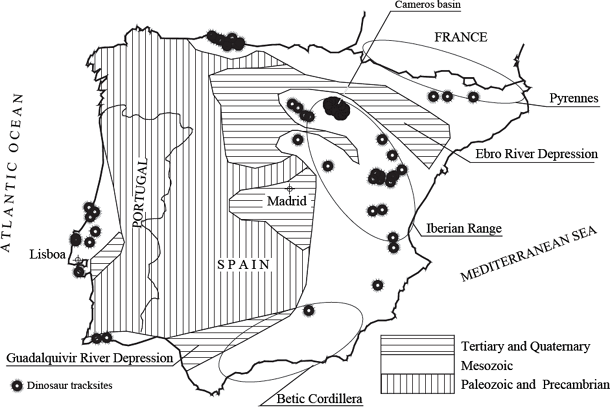
1.1. Schematic geological and geographical representation of Iberian Peninsula showing location of dinosaur tracksites (modified from Prez-Lorente, Romero, and Torcida, 2002). Locations of outcrops of Mesozoic rocks in Iberian Peninsula that potentially contain dinosaur fossils are shown in white; areas marked with lines show those that cannot contain fossils because they are the wrong age. Regions marked with vertical lines have rocks from before the time of dinosaurs (Precambrian and Paleozoic); regions marked with horizontal lines are post-Cretaceous (Cenozoic: after the dinosaurs).
La Rioja Footprints | 1 |
THE SPANISH PROVINCE OF LA RIOJA IS AN AREA OF THE WORLD where a huge number of dinosaur footprints have been found, with many more likely yet to be discovered. This hilly region has many rock slopes with layers so full of tracks that, if the vegetation, loose rock, and debris could be removed, would yield from 8000 to as many as 25,000 footprints. Using the best estimates from some slopes that is, the maximum estimate from that partial data there may be as many as 70,000 footprints.
Many of the footprints are so easy to see that the first people to discover them were likely shepherds or hunters who passed through the area. However, the identity of the first person to correctly interpret them is another question. The footprints are so evocative that the inhabitants of the region have long associated them with animals. In the villages of Enciso, El Villar, and Poyales, there were people who thought the footprints now understood to be those of theropod dinosaurs had been made by giant chickens. In the village of Navalsaz, it was said that the ornithopod footprints of the Cuesta de Andorra had been made by huge lions. It is difficult to know exactly how long such claims have been made, whether the local population even knew about wild animals such as lions, or whether this interpretation was offered by visitors to the region.
The footprints have also been attributed to animals from medieval mythology, in some cases inspired by religion. For example, in Igea, it was said that the footprints had been left by the horse of the apostle James on his travels. Popular tradition has it that James helped the Christians in their wars against the Muslims. As with the legendary mule tracks of Setubal in Portugal, there is no end of imaginative interpretations. In some cliffs to the south of Lisbon (Portugal) there are some dinosaur footprints which the ancient Portuguese interpreted as being miraculous. Miguel Telles Antunes (1976) says that according to legend, the Virgin Mary Santa Maria da pedra da mua (or an image of her from the 18th century) had come out of the sea and ascended to the top of the cliff while sitting on a mule. During the ascent, the mule left the footprints on the wall. According to Antunes, this tradition may date back to the 13th century. In Igea, the horses footprints are visible near the Santa Ana chapel, at the place where the apostles horse was said to have jumped 3 km to land near the shrine of the Virgen del Villar, where it also left footprints. Interpretations such as these are to be expected, given the knowledge of the population. For example, the presence of marine fossils in many places had to be explained as a whim of nature. Even if no one could explain why, the sea must have been there. Nature is capable of wonderful things! Even today, if you ask an old farmer or shepherd how the sea could ever have been so far inland, although he may not be able to provide an explanation, no one will be able to convince him it was not so. For the people, the rocks, rivers, sea, and mountains have always been where they are at present. In their village, there was never a sea.
Nor would any of the local inhabitants have been able to predict that the sloping rock strata on which the tracks appear had once been horizontal mudflats. It is understandable that people did not consider that normal animals could leave their footprints in such hard rock, whereas the horse of Saint James might have had magical properties that allowed it to make an impression in solid rock. It may have been the wish of the saint or even the horse that the footprint left behind had a shape very different from that left by a typical horse.
It is likely that almost all settlements with dinosaur footprints had traditions and legends surrounding them that have since been lost or that the older generation do not want to tell to strangers.
The first publication about dinosaur footprints in the Iberian Peninsula that I have in my possession is from Jacinto Pedro Gomes (19151916) for Cabo Mondego (Portugal), and the first in Spain is from Albert F. de Lapparent (1965) for the east (province of Valencia). Although geological research began in La Rioja a long time ago, the footprints were not recognized until 1969, when the first publication about dinosaur footprints in La Rioja appeared in the newspaper El Correo Espaol El Pueblo Vasco. The authors were Moiss Iglesias Ponce de Len, a geologist, and Luis Vicente Elias, an ethnologist, who found the footprints while doing fieldwork on the customs of the people from the Cameros region. After this discovery, a number of favorable events occurred.
The first was that the news was not published just in the newspaper. Almost immediately, a learned researcher, Blas Ochoa, who was a schoolteacher from Enciso, began collaborating with a team of vertebrate paleontologists, Maria Lourdes Casanovas and Jos Vicente Santaf. The team described five sites in two publications in 1971 and 1974. The two publications and comments from townspeople who had known the paleontologists inspired two groups of amateurs to search for new sites in their spare time and publish their findings as a challenge to other researchers. By 1979, nine sites had been identified, all near the village of Enciso. (These groups are still working, partly because they have active members and partly because we have followed in their footsteps in looking for new track sites.) Later, a schoolteacher from Igea, Angel Gracia, taught his pupils the importance of fossils and showed them how to search for, classify, and preserve them. His students found sites with footprints near the village, one of which remains to be studied.
Next pageFont size:
Interval:
Bookmark:
Similar books «Dinosaur Footprints and Trackways of La Rioja»
Look at similar books to Dinosaur Footprints and Trackways of La Rioja. We have selected literature similar in name and meaning in the hope of providing readers with more options to find new, interesting, not yet read works.
Discussion, reviews of the book Dinosaur Footprints and Trackways of La Rioja and just readers' own opinions. Leave your comments, write what you think about the work, its meaning or the main characters. Specify what exactly you liked and what you didn't like, and why you think so.


